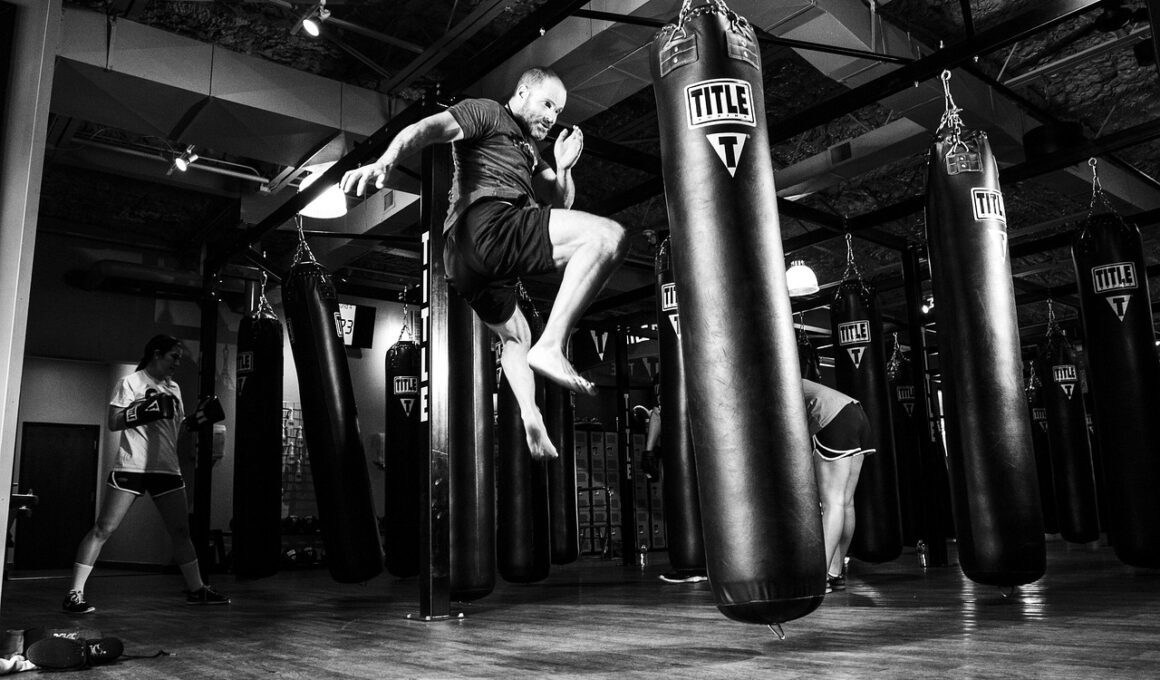Martial Arts Drills to Enhance Agility and Endurance
Agility and endurance are critical components of martial arts success. To enhance these qualities, specific drills can be implemented into training regimens. Understanding the importance of both agility, which allows for quick movements, and endurance, which enables prolonged physical exertion, is vital for practitioners. Various drills can be effective at building these skills, ensuring that martial artists can execute techniques efficiently and effectively. A few methods for developing these capabilities include ladder drills, cone drills, and shadow boxing. Each of these drills focuses on different aspects of movement and stamina, directly correlating with martial arts performance. For instance, ladder drills involve quick footwork patterns that boost overall agility, while cone drills emphasize direction changes, crucial in combat situations. Incorporating these drills into regular training keeps workouts dynamic and engaging, often resulting in substantial improvements. If you wish to learn more about specific drills, consider attending local martial arts classes or finding a training partner. You can also visit online resources or forums to connect with other martial artists committed to enhancing their agility and endurance through targeted training.
One effective drill for improving agility is the staggered stance movement drill. This exercise focuses on helping martial artists transition quickly between different stances, enhancing footwork and coordination. To perform this drill, start in a fighting stance and alternate between leading with your left and right foot. This repetition trains the body to adapt quickly to various positions needed in sparring or competition. Another excellent drill for agility enhancement is lateral shuffles. To execute this, set up two markers a few feet apart and shuffle side to side. This action develops lateral movement, which is often vital during fights, particularly in avoiding strikes or closing distances. Incorporating arm movements can also add an upper body component, simulating a realistic fighting scenario. Try increasing the speed and intensity as you develop confidence to push your limits further. It’s crucial to maintain proper form throughout to prevent injuries while maximizing benefits. Additionally, take time to rest and recover. Remember that integrating these drills into workouts can lead to significant improvements in agility and overall performance during training or competition.
Building Endurance through Interval Training
Interval training is another effective method to build endurance necessary for martial arts. This type of training alternates periods of intense activity with rest or lower-intensity exercises. This pattern helps improve cardiovascular fitness while simulating the stop-and-go nature of martial arts. An excellent way to incorporate interval training is through circuit workouts, which can include various martial arts techniques, such as striking, kicking, and grappling. One example would be performing a set number of punches followed by high knees then resting for a short period before repeating. This cycle can be customized to various skill levels and can vary in length, promoting engagement and challenge. Moreover, ensuring proper recovery time is essential for improving endurance over time. Stay hydrated and nourished, supporting your body adequately during training sessions. The benefits of this training approach extend beyond just physical improvements; it also builds mental resilience and confidence. Practitioners who engage in interval training often find they can endure longer during sparring sessions or competitions, ultimately enhancing their overall performance in martial arts.
Another drill that enhances endurance is long-distance running or jogging. Many martial artists incorporate this simple yet effective cardiovascular exercise into their training routines. This form of aerobic activity builds stamina by challenging the body over extended durations, preparing it for the demands of martial arts practices. Joining a running group or finding a training partner can help keep you motivated during longer runs, making it more enjoyable. Incorporating various workouts like hill sprints or fartlek training can elevate endurance results. Such diversity in training keeps exercises engaging and provides opportunities to enhance speed and power over time. When committing to a running routine, remember to maintain strong mental focus and consistency. Additionally, track your progress using a fitness app or journal, which can encourage accountability while providing benchmarks for improvement. Staying dedicated will build physical endurance and translate into an improved performance in martial arts training. Also, never underestimate the importance of rest days, ensuring the body heals and can adapt. These developing strategies contribute significantly to a martial artist’s overall skills and capabilities, especially in high-pressure environments.
Incorporating Plyometrics for Agility
Plyometric exercises can be another useful tool for enhancing agility and endurance in martial arts. These high-intensity movements involve explosive exercises like jump squats, box jumps, and burpees. Plyometrics focus on increasing power and speed, which translates directly into improved martial arts performance. By working on these explosive movements, practitioners can learn to transition quickly between techniques, which is a crucial skill in sparring and competition. Integrate plyometric exercises into your strength training routine for maximum benefits. An example of a plyometric drill involves performing squat jumps while maintaining proper form. Aim for consistent height and speed to optimize results while being cautious of joint impacts. Consistency in pacing and gradual increasing difficulty will ensure optimal progression without risking injury. Plyometric training can be exhausting, so monitor your body’s response. Adequate recovery between workout sessions and proper nutrition will support muscle repair and endurance enhancement. Moreover, finding new creativity by pairing plyometrics with traditional martial arts techniques can make training more enjoyable and effective.
Another effective way to improve agility and endurance is by incorporating agility ladders into your training. These ladders can facilitate a range of drills that enhance footwork, coordination, and speed significantly. Using agility ladders, practitioners can perform various foot patterns that can challenge their balance and reflexes. Exercises such as in-and-out foot placements or lateral side shuffles can emphasize how movement dictates technique. A proper routine would involve a warm-up, followed by working through various ladder drills in sequences that cater to specific athletic challenges. Eventually integrating speed and complexity helps reinforce patterns while building muscle memory. Additionally, striving for improvement through timed sets can lead to stronger results and heightened competitive spirit. Keeping a notebook of your progress can provide motivation when aiming for performance goals. Furthermore, adjusting ladder drill complexity could prevent monotony and enhance engagement. Pairing workout partners can make these drills even more enjoyable and challenging. Overall, incorporating agility ladders into your routine will undoubtedly provide noticeable benefits in both agility and endurance, leading to overall martial arts success.
Final Thoughts on Training for Results
Incorporating various techniques to enhance agility and endurance is vital for martial artists aiming for overall success. Effective training involves a combination of agility drills, interval training, running, plyometrics, and agility ladders, collectively focusing on improving physical capabilities. Each method presents unique challenges to practitioners, ultimately leading to growth in skills, stamina, and confidence. Martial artists must remember to balance intensity with adequate recovery time, as this fosters long-term improvements. Additionally, tracking progress and setting achievable goals can ensure that motivation remains high throughout training. Engaging with the martial arts community and sharing experiences can foster encouragement and positive competition. Martial arts training can be both demanding and rewarding, and staying committed is crucial. Consistent effort and smart training approaches significantly impact one’s performance on the mat. Enjoying the learning process along the journey is essential as you sharpen skills. Through informed and deliberate practice, martial artists can significantly enhance their agility and endurance, ensuring they excel in their respective disciplines while enjoying the physical and mental benefits of martial arts.
In closing, remember that improving agility and endurance is a continuous process that ultimately pays off in martial arts. The variety of drills discussed can be easily incorporated into any training regimen, making workouts engaging and motivating. As you progress, reassess your goals and see where you can further challenge yourself. Each improvement you make is a step closer to your martial arts aspirations. The journey provides valuable lessons and helps develop perseverance, discipline, and resilience. With dedication and a willingness to learn, martial artists can achieve their goals while experiencing personal growth. Don’t hesitate to reach out to instructors or fellow enthusiasts for feedback or support along the way. Staying open to new techniques and training methods allows for continuous growth, fostering both physical and mental enhancements necessary for martial arts success. Your health and fitness will benefit greatly, enhancing not only performance but also overall well-being. Embrace the process, and let agility and endurance training become a rewarding part of your martial arts journey.


